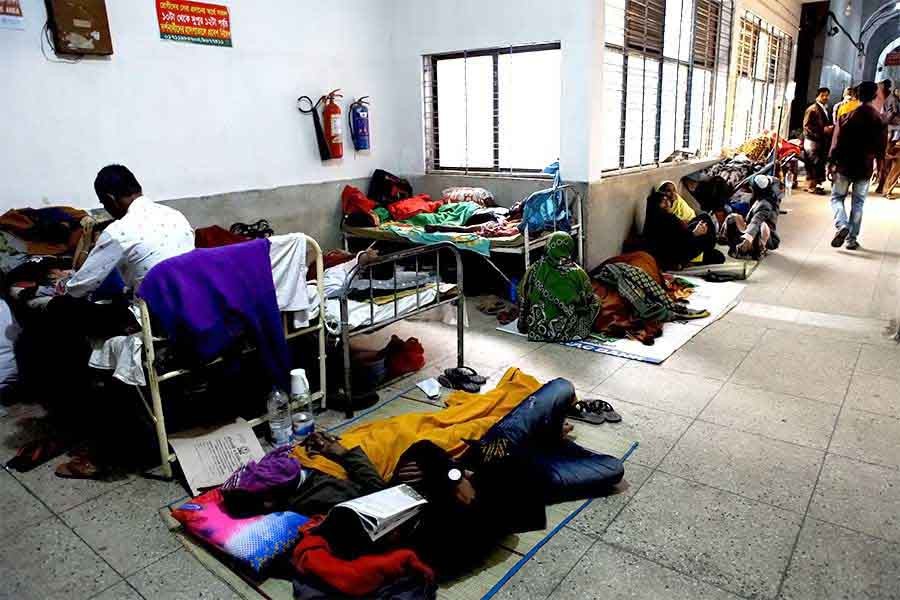
Published :
Updated :

That the patients' per capita out-of-pocket (OPP) health expenditure, as revealed by a recent government report, went up 4.0 per cent between 2012 and 2015 is nothing surprising.
It, in all probability, has again gone a few percentage points up since then. The report, titled, Bangladesh Health Accounts 1997-2015, unveiled late last week by the Health Economics Unit (HEU) in Dhaka, said per capita OOP health expenditure increased from 63 per cent in 2012 to 67 per cent in 2015.
The finding of the report comes in contrast to the objectives of the National Health Policy (NHP) of 2011. The Policy aimed at reducing such payments by half and raising the level of government spending by 4.0 percentage points to 30 per cent over the next two decades.
In fact, the government's share in per capita health spending declined by 3.0 per cent between 2012 and 2015, highlighting the fact that the government has utterly failed to follow the objectives of the new health policy.
The Bangladesh Health Accounts estimate does not give the actual picture of the per capita expenditures on health, for the estimate is an average one. The truth is that the patients belonging to middle and upper classes themselves bear their entire health-related expenses. It is the poor and lower middle class that have a share in the allocations the government makes in the national budget every year. The middle and upper middle classes usually take the services offered by the private hospitals, clinics and diagnostic centres where the government does not make any financial contribution.
One of the primary reasons for OOP health expenditure going up in recent years has been the unabated increase in prices of medicines. According to, the latest report of the HEU, of the total OOP payments, around 70 per cent is made on account of medicines. The government has given the pharmaceutical companies free-hand to fix their prices the way they deem fit. Barring a few essential drugs, the government does not have any control over the prices of hundreds of generic medicines, including life-saving ones.
What the leading local pharmaceutical companies usually do is that they deliberately create an artificial crisis of certain medicines in the retail market through short-supply of the same. This, invariably results in the hike in the prices of the same. After some days, the companies themselves increase the price of the same medicines and ensure their abundant supply in the market.
The country's pharmaceutical industry has prospered remarkably over the last three and a half decades, thanks to the protection they got from the government at home and the World Trade Organisation (WTO) at the international level as a least developed country.
But the irony is that the benefit the industry received from all directions has not been passed on to the poor patients. Whenever the issue of drug pricing is raised before the pharmaceutical companies, they do flatly deny any unfair hike, claiming that locally manufactured drugs are cheaper compared that of any other country. But they tend to forget the actual average daily income of the poor and low income people in this country.
Moreover, the government's spending on health sector has always been well below the requirement. In recent years it never crossed 5.0 per cent of the total allocations made under both development and revenue budgets. More importantly, the major part of the allocation made in the revenue budget for the health sector, is spent on salaries and other contingencies. Only a small amount is used for the procurement of medicines and other medical needs of patients. Then again, a notable part of the procured medicines and other necessities is pilfered by a section of unscrupulous employees in government health facilities. What finally reaches the poor patients visiting the government health facilities is awfully inadequate to meet their medical needs. They are, thus, compelled to buy medicines and meet diagnostic requirements from outside.
There is no denying that the public sector health facilities have expanded notably in recent years. But the physical infrastructures do have little value if the patients visiting those remain deprived of necessary care and attention from qualified physicians and attendants or they are made to buy almost everything from outside.
The situation in public health facilities located in rural areas bears the testimony to that fact. Doctors, mostly newly recruited ones, skip their duty and live in urban centres, mainly Dhaka. The small operation theatres in the Upazila health complexes, in most cases, lack necessary amenities and the ambulances and other diagnostic equipment remain out-of-order for lack of care and maintenance. Despite repeated warnings from the big wigs in the health sector, the situation remains unchanged. All these have been largely responsible for forcing the poor and low-income patients to spend more from their own pockets. The OOP payments on the patients would continue to rise until and unless the government makes a healthy allocation for the health sector annually and ensure their proper use for the greater good of the poor and low-income people.


 For all latest news, follow The Financial Express Google News channel.
For all latest news, follow The Financial Express Google News channel.